
* In the postwar period, the McDonnell Aircraft Company of Saint Louis, Missouri, developed a series of pioneering jet fighters for the US Navy in the 1950s -- beginning with the "F3H Demon", which had a short service life, and led to the much-improved "F4H Phantom". The Phantom would prove extremely successful, being produced in a succession of variants, and adapted to roles such as reconnaissance and defense suppression. This chapter describes the different variants of the Phantom in US service. A few other variants that only flew in foreign service are discussed in a following chapter.
* The McDonnell Aircraft Company was founded in 1939 by James S. McDonnell. The company survived the war years through subcontract work for major aircraft manufacturers such as Grumman and Vought. The McDonnell firm did develop a prototype twin-piston-engine interceptor during the war, the "XP-67 Moonbat", but it did not reach production.
At the end of the war, the company produced the US Navy's (USN) first operational jet fighter, the "FH-1 Phantom", which performed its initial flight in 1945. Only 60 FH-1s were built, since its performance wasn't much better than that of current piston-engined fighters, but it did lead to the much more successful "F2H Banshee", a scaled-up and improved Phantom. First flight of the Banshee was in 1947, and 895 were built, with the type performing service in the Korean War.
Even as McDonnell was producing the Banshee, the company was working on a more advanced naval jet fighter. In 1948, the US Navy Bureau of Aeronautics (BuAer) issued a request for proposals for a new carrier-based interceptor with performance at least equal to that of land-based fighters then on the drawing boards. A total of eleven companies submitted proposals; in December, the McDonnell "Model 58" design was selected as the winner, with a contract issued for two prototypes as the "XF3H-1" in September 1949, after inspection of a full-scale mockup. The runner-up in the competition, a delta-wing design from Douglas, was seen as promising enough to encourage the Navy to pursue its development as well -- that aircraft emerging as the "F4D Skyray", but that's another story.
The XF3H-1 design had been produced by a team under McDonnell's Richard Deagan. It was a single-seat fighter with swept flight surfaces, low-mounted wings, side-mounted engine intakes, and a single Westinghouse afterburning J40 turbojet. The McDonnell team wanted to use twin engines, but the Navy planned to standardize on the J40 and had insisted on its use -- a decision that would be regretted.
While work on the XF3H-1 prototypes proceeded, the Navy reconsidered the requirement and decided that the production machines would be all-weather / night fighters instead of day fighters, to be designated "F3H-1N". The prototypes were built to the original specification as demonstrators, with the first "Demon" -- as it was named in keeping with the supernatural theme of McDonnell aircraft -- performing its first flight on 7 August 1951, the pilot being Robert M. Edholm. A non-afterburning XJ40-WE-6 engine with a maximum thrust of 24.9 kN (2,540 kgp / 5,600 lbf) was fitted since an afterburning J40 wasn't available at the time. The second prototype, also fitted with the non-afterburning engine, performed its initial flight in January 1952. The two prototypes were unarmed and lacked radar.
Initial trials demonstrated that the J40 was highly unreliable; the aircraft's forward field of view was unsatisfactory; while roll rate and yaw stability were poor. The nose was redesigned to improve field of view, while flight surface modifications took care of the roll and yaw problems. As far as the unreliability of the J40, that might have been unsurprising for a new engine -- but after the second prototype was fitted with an afterburning J40-WE-8 engine, providing an afterburning thrust of 46.7 kN (4,760 kgp / 10,500 lbf), in early 1953, things didn't get much better. The first prototype was lost in a crash on 18 March 1954, and the second prototype was grounded not long after.
In short, things weren't looking at all well for the Demon. The Navy had optimistically ordered the F3H-1N into production even before the flight of the first Demon prototype, following up that order with one for a batch of "F3H-1P" reconnaissance machines -- though no reconnaissance Demons would ever be built. Despite the problems with the prototypes, the Navy was frantic to get more advanced aircraft to counter Red MiGs over Korea, and so production of the F3H-1N went ahead, with the first performing its initial flight on 24 December 1953.
The F3H-1N differed from the prototypes in having more fuel capacity; AN/APG-30 radar in a modified nose; four 20-millimeter cannon, mounted in the belly under the cockpit; and various small changes. Initial engine fit was a Westinghouse J40-WE-8 turbojet with 32.0 kN (3,265 kgp / 7,200 lbf) dry thrust and 46.7 kN (4,760 kgp / 10,500 lbf) afterburning thrust, but later production featured the J40-WE-22 with 33.4 kN (3,400 kgp / 7,500 lbf) dry thrust and 48.5 kN (4,945 kgp / 10,900 lbf) wet thrust. Even the J40-WE-22 engine was seen as inadequate, not close to achieving the J40's expected levels of thrust, but the plan was to upgrade to a more satisfactory J40 variant when it became available.
There was no future in the J40, however. The F3H-1Ns were plagued by engine failures, some of them catastrophic and resulting in fatalities. The news media played up the Navy's "dangerous" aircraft, and production was halted after only 58 examples were built. Many of those that were rolled out never flew, with most or all being scrapped. Westinghouse never got the J40 engine to work right, and soon departed from the jet engine business.
* The failure of the J40 engine did not reflect too badly on McDonnell, all the more so because company engineers hadn't wanted to use the J40 in the first place. Back in November 1952, as the difficulties with the J40 were becoming obvious, McDonnell had pitched the idea of fitting an Allison J71 turbojet to the Demon in place of the Westinghouse J40. The Navy was hesitant, having specified the J40 as the way of the future -- but a little insurance wouldn't hurt, and so the BuAer authorized investigation of a J71-powered Demon, to be designated "F3H-2N".
A mockup was inspected in August 1953; in November 1953, BuAer modified the F3H-1N contract to specify that two of the F3H-1Ns would be completed with the J71 engine. They would also be reconfigured as all-weather multirole fighters, the main change being a wing increased in area by 17%. The initial F3H-2N prototype performed its first flight on 23 April 1955. By that time, the Navy had already modified the F3H-1N contract to specify production of F3H-2Ns, with the first of 140 production machines performing its initial flight on 23 April 1955.
The F3H-2N was externally very similar to the F3H-1N -- aside from the larger wing -- being a single-engine fighter with side-mounted intakes, swept flight surfaces, low mounted wing, plus four 20-millimeter cannon for armament. Each wing had full-span leading-edge slats, a large one-piece flap inboard, an aileron outboard, and a wing fence about three-quarters of the way out on the span. The outer wings folded up hydraulically for carrier deck storage. The tailplanes were "all-moving"; there was a hydraulically-actuated airbrake on either side of the rear fuselage, just behind the wing.
The F3H-2N was powered by an Allison J71-A-2 turbojet with 44.5 kN (4,535 kgp / 10,000 lbf) dry thrust and 64.1 kN (6,530 kgp / 14,400 lbf) afterburning thrust; in service, F3H-2Ns would be upgraded to J71-A-2A or J71-A-2B engines, with the same thrust ratings but various technical improvements. The quad 20-millimeter cannon armament of the F3H-1N was retained, but a more capable AN/APG-51 radar was fitted. Two stores pylons were fitted under each wing, for a total of four, and two external tanks with a capacity of 993 liters (262 US gallons) each could be carried side-by-side under the fuselage -- though usually only one was carried, since two produced turbulence. Many F3H-2Ns were later wired to carry up to four AAM-N-7 (later AIM-9B) Sidewinder air-to-air missiles (AAM) on the wing pylons. Demons in service would also be fitted with a retractable probe on the right side of the nose for probe-and-drogue inflight refueling.
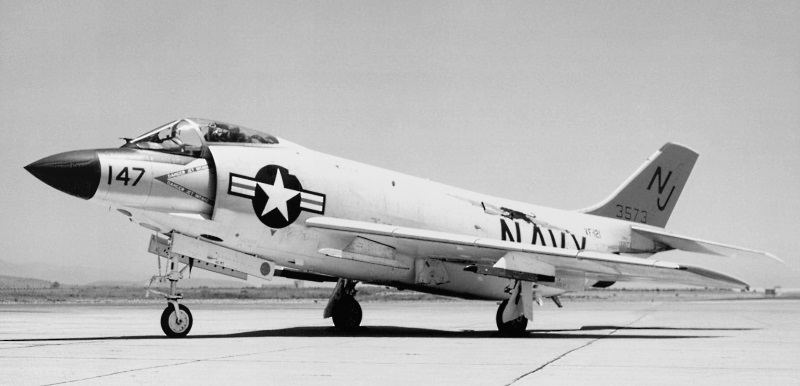
A "missile carrier" version, the "F3H-2M", was built in parallel with the F3H-2N. The F3H-2M could carry four AAM-N-2 Sparrow I AAMs, one on each underwing pylon, and was fitted with an AN/APG-51B radar to direct the AAMs. The Sparrow I was a "beam rider", riding down the radar beam to the target. Initial flight of the F3H-2M was on 23 August 1955, and 80 were built.
* The F3H-2N and F3H-2M led to the definitive "F3H-2" variant, which could carry the much-improved AAM-N-7 (later AIM-7C) Sparrow III. The Sparrow III was a "semi-active radar homing" AAM, meaning that instead of just following the radar beam, it homed in on radar reflections from the target, ensuring much greater accuracy. The F2H-2 was fitted with an AN/APG-51B radar set to control the Sparrow IIIs; Sidewinder AAMs could still be carried as well.
The F3H-2 also featured a British Martin-Baker Mark 4 ejection seat; the ejection seat fitted to early Demons, presumably a McDonnell design, had proven dangerously unreliable. It isn't clear when the Martin-Baker seat was introduced in Demon production; it may not have been a new feature in the F3H-2.
___________________________________________________________________
MCDONNELL F3H-2 DEMON:
___________________________________________________________________
wingspan:
10.77 meters (35 feet 4 inches)
wing area:
48.22 sq_meters (519 sq_feet)
length:
17.96 meters (58 feet 11 inches)
height:
4.44 meters (14 feet 7 inches)
empty weight:
10,040 kilograms (22,133 pounds)
MTO weight:
15,377 kilograms (33,900 pounds)
max speed at altitude:
1,040 KPH (645 MPH / 560 KT)
service ceiling:
13,000 meters (42,650 feet)
range:
2,205 kilometers (1,370 MI / 1,190 NMI)
___________________________________________________________________
The F3H-2 was enhanced for the strike fighter role, with six underwing pylons instead of four. It could carry up to 2,720 kilograms (6,000 pounds) of bombs or rockets, and could also carry a tactical nuclear weapon. Other than the additional stores pylons, the only external difference of the F3H-2 from the F3H-2N and F3H-2M was a slightly shorter tail cone. A total of 239 F3H-2s was built, the last delivered in April 1960. Some F3H-2Ns were updated for Sparrow III carriage and redesignated "F3H-2N/2". Oddly, no F3H-2Ms were updated for the Sparrow III.
An "F3H-2P" reconnaissance variant was proposed, but never built. An "F3H-3" with a General Electric J73-GE-3 engine, rated at 40.9 kN (4,170 kgp / 9,200 lbf) dry thrust and 57.4 kN (5,850 kgp / 12,900 lbf) afterburning thrust, was ordered, but in the end these machines were delivered as F3H-2s.
The Demon finally entered Navy service in early 1956, performing its first fleet deployment in early 1957. Ultimately, a total of 22 Navy squadrons would fly the Demon, not counting training and evaluation units. An "F3H-2P" reconnaissance variant was proposed, but never built. An "F3H-3" with a General Electric J73-GE-3 engine, rated at 40.9 kN (4,170 kgp / 9,200 lbf) dry thrust and 57.4 kN (5,850 kgp / 12,900 lbf) afterburning thrust, was ordered, but in the end these machines were delivered as F3H-2s.
519 Demons were built in all, variants including:
Pilots liked the Demon, enjoying its docile handling, but its endurance was marginal, and it was underpowered; two of the cannon were often removed to cut weight, with the cannon ports faired over. Its fleet service was brief, since combat aircraft design was advancing rapidly at the time, and the Demon's problems with the J40 engine had delayed its introduction. By the early 1960s, the Demon was being replaced by more advanced types.
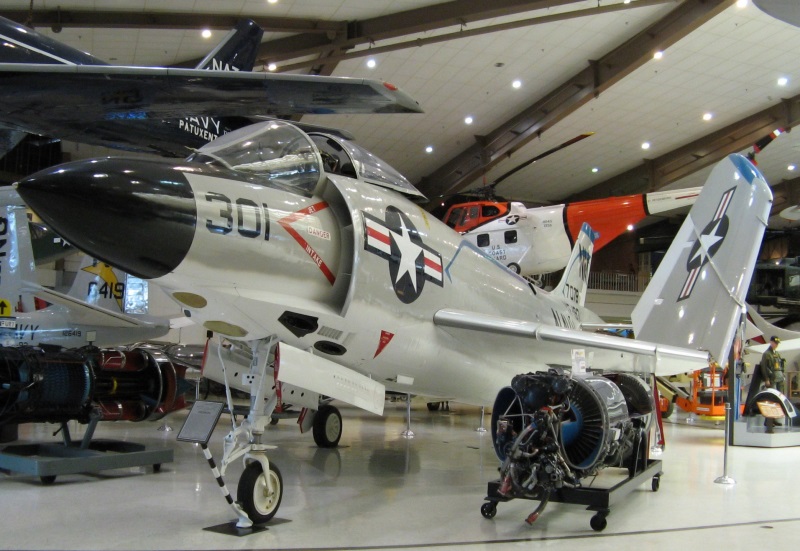
The Demon was formally out of fleet service by the end of 1964, though a few would be flown in trials and the like for a few years after that. By the time of its retirement, the designations had been changed, with the implementation of the "tri-service" designation scheme in 1962:
The Demon never served with any foreign air arms, and never fired a shot in anger. Some survive on static display, but none remain airworthy.
BACK_TO_TOP[1.2] PHANTOM ORIGINS
* As a follow-up to the Demon, in the early 1950s McDonnell began design studies for a more advanced naval fighter-bomber, with the effort conducted under a team led by Herman D. Barkey. Early concepts envisioned a single-engine aircraft with four 20-millimeter cannon. Since the Demon was the starting point for these designs, they were given company designations of "F3H-C", "F3H-E", and "F3H-G".
The F3H-C and F3H-E were single-seat, single-engine aircraft, with the F3H-C very much resembling an improved Demon, while the F3H-E was more of a departure. The F3H-G was much more interesting than either, at least in hindsight. The F3H-G was a single-seat twin-engine aircraft, to be powered by twin Wright J65 turbojets, license-built British Rolls-Royce Sapphire axial-flow engines. The F3H-G incorporated features from the Demon, as well as the McDonnell F-101 Voodoo, a twin-engine interceptor the company was developing for the US Air Force (USAF).
Although the "F" in the F3H-G designation indicated a fighter, the designers saw it as a multirole combat aircraft that could be adapted to different roles by splicing on a new forward fuselage. Possible variants included:
Since aircraft were becoming increasingly complicated during the 1950s, McDonnell also proposed a tandem two-seat version of the F3H-G, with the "back-seater" taking care of the aircraft's electronic systems.
* McDonnell passed the F3H-G design on to the Navy Bureau of Aeronautics (BuAer) in the fall of 1953, only to have it rejected in a few weeks. One of the reasons for the quick rejection was that the Navy had just signed contracts for the Vought F8U-1 Crusader as its first supersonic fighter, and felt it met the service's immediate needs. However, the Navy encouraged McDonnell to continue work on the concept, and the design team went on to build a mockup of the F3H-G, completing it in early 1954. Senior Navy officials were invited to Saint Louis to look it over.
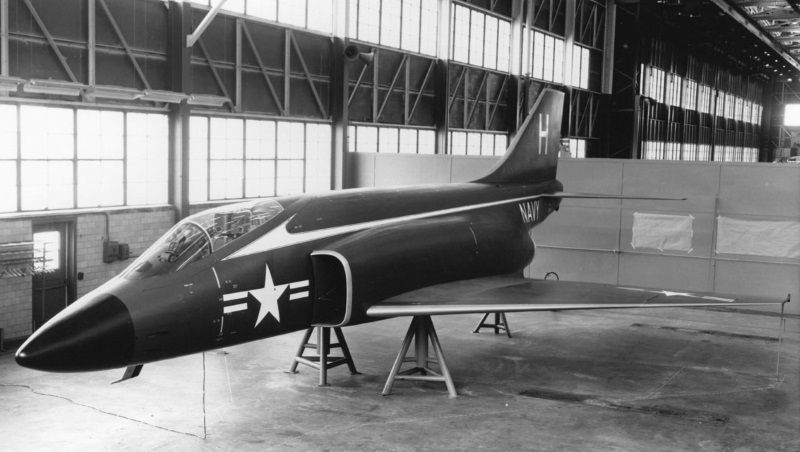
The F3H-G concept then began to converge with reality. In mid-1954, BuAer issued a request for a new all-weather fighter. McDonnell submitted both the single-engine F3H-E and the twin-engine F3H-G proposals, with Grumman and North American submitting proposals as well. The BuAer selected the F3H-G, issuing a "letter of intent" for two prototypes of the type, now to be designated "AH-1", on 18 October 1954.
That was very encouraging, but there was also less to it than met the eye. The Navy was still considering needs, and in the absence of specific requirements there was no way to move on to "cutting metal". However, the brass were definitely giving the matter serious thought, and over the following months clarified their needs. In the end, what they wanted was a carrier-based fleet defense interceptor that could patrol at a combat radius of 465 kilometers (250 nautical miles) for over two hours. As the machine was clearly no longer an "attack" aircraft, the designation was changed to "F4H-1".
Although the McDonnell mock-up had featured four 20-millimeter cannon, the Navy wanted the F4H-1 to be armed only with missiles, specifically four of the new Sparrow AAMs. This was a great age of optimism in the whizzy new missiles, and gun armament was for the moment seen as obsolete. The decision to delete the cannon would come back to haunt the Navy.
McDonnell engineers tweaked their concepts, and within weeks gave the Navy a modification of the original F3H-G design. The new aircraft would be armed with four Sparrows, mounted on extensible racks under the fuselage. The designers also decided to abandon the Wright J65 engine, which would have given the F4H-1 a top speed of Mach 1.5, and instead adopt the new General Electric J79-GE-2 turbojet, then the state-of-the-art in jet engine design. Two J79s would give the F4H-1 a top speed of Mach 2.
McDonnell proposed both single-seat and two-seat versions of the F4H-1; the Navy promptly selected the two-seat variant. One final change was to delete the stores pylons, except for a centerline pylon for a drop tank, with a tank eventually designed with a capacity of 2,270 liters (600 US gallons). A formal contract was signed on 25 June 1955 for two "XF4H-1" prototypes and five "YF4H-1" pre-production aircraft.
BACK_TO_TOP* The first XF4H-1 was rolled out on 8 May 1958. Its initial flight was on 27 May 1958, with Robert C. Little, McDonnell's chief test pilot, at the controls. There were minor problems with the first few flights, but in a few days the aircraft was flying well.
By this time, the XF4H-1 had competition. The Navy wanted to hedge bets on their new fleet-defense interceptor, and so the Vought company had submitted a rival design, the XF8U-3 Crusader III, a fast and powerful aircraft that amounted to a bigger and badder descendant of the Vought Crusader, then going into Navy service. There was a competitive fly-off between the XF4H-1 and the XF8U-3 in the fall of 1958. The McDonnell design was selected as the winner on 17 December 1958. Although the Crusader III was an impressive aircraft and might have been capable of Mach 3, it was a single-seat, single-engine aircraft. The Navy felt, correctly, that a back-seater was required to handle the electronic systems of a modern fighter, and that twin engines offered greater survivability.
By the spring of 1959, McDonnell had orders for 40 more F4H-1s, in addition to the original order for seven, and by summer eight machines were flying. On 3 July 1959, the McDonnell Corporation celebrated its 20th anniversary, and the F4H-1 was formally given the name "Phantom II", in honor of the FH-1 Phantom. However, the FH-1 hadn't been produced in quantity, didn't have a long service life, and had been largely forgotten, so the "Phantom II" quickly became the "Phantom".
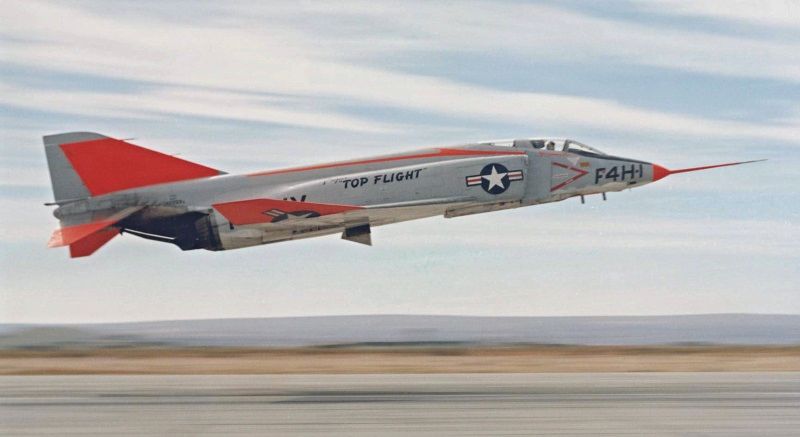
* The Phantom began carrier trials began in the fall of 1959, with the first carrier take-off performed on 15 February 1960. In the meantime, while the type was being qualified for operational service, it was also breaking speed and altitude records.
The second XF4H-1 set the first record, reaching an altitude of 30,048 meters (98,557 feet) with a "zoom climb" under Operation TOP FLIGHT on 6 December 1959. Similar exercises were conducted over the next 28 months. Highlights included:
The Phantom was proving it could fly. The next step was to see if it could fight, but that would have to wait a few years.
BACK_TO_TOP* The XF4H-1 Phantom provided a baseline for the Phantom family that would, with various changes, be retained through the production life of the type.
The Phantom that was rolled out of the McDonnell factory very much resembled the original F4H-1 concept, but also unsurprisingly incorporated a number of refinements dictated by changed requirements; wind-tunnel tests; and improved design calculations.
The general configuration of the aircraft remained unchanged. As with the initial design, the XF4H-1 featured twin engines, one mounted on each side of the fuselage, with intakes just behind the pilot and next to the back-seat position, and exhausts under the tail. A stinger-type arresting hook was mounted on the tail between the exhausts. The single-wheel main gear hinged in the wings, retracting towards the fuselage, and the twin-wheel nose gear retracted backwards. The nose gear was steerable through 360 degrees, and had hydraulically-boosted steering.
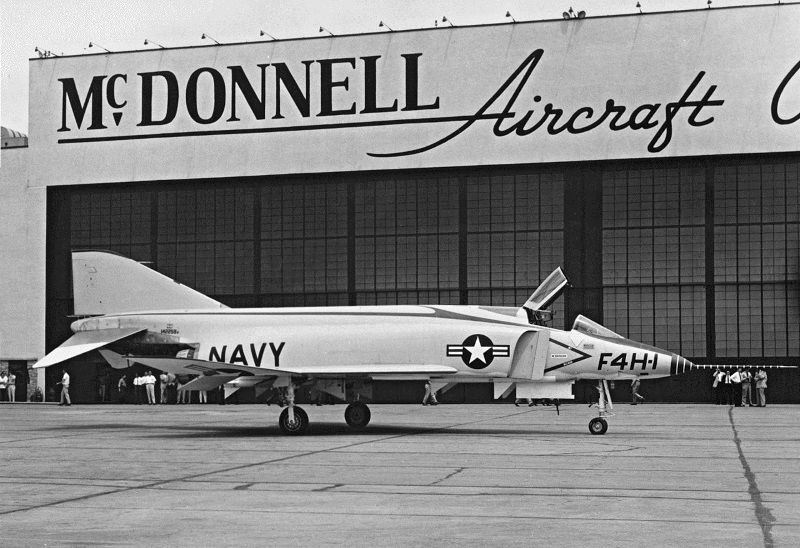
The low-mounted wings retained their broad, strongly sweptback configuration. In the original F3H-G design they had no dihedral, but in development the outer wing panels were given 12 degrees of dihedral to provide stability about the roll axis. The panels were also extended forward to create a distinctive "dogtooth" that helped prevent wingtip airflow separation. The panels folded upward, using a hydraulic actuation system, for carrier storage. Some variants of the Phantom would delete the hydraulics for the wing fold, but every Phantom ever built would have folding wings, even though the majority of them never flew off a carrier deck.
The Phantom did not have traditional ailerons that could tilt up and down to provide roll control. It instead used "flaperons", flaplike underwing surfaces outboard of the main flaps. The flaperons, like the flaps, could only tilt down, but worked in conjunction with overwing spoilers to provide roll control.
The Phantom was also fitted with leading-edge flaps. The trailing-edge flaps and the flaperons deflected 60 degrees, while the inboard leading-edge flaps deflected 30 degrees. In addition, the aircraft featured a "boundary layer control (BLC)" or "blown flaps" scheme, in which engine bleed air was blown over the flaps and flaperons to increase their effectiveness at low speed, improving low-speed handling for carrier landings. The Phantom was one of the first operational aircraft to use BLC.
The tailplane, which was of "all-flying" or "all-moving" configuration and called a "stabilator", had been flat in the original F3H-G concept, but had acquired a distinctive 23-degree anhedral droop. That was done to ensure that the stabilator remained effective at high angles of attack, while keeping it out of the engine exhaust flow.
* Considerable thought was put into the J79 engine installation. A large, fixed, sharp-edged "ramp" or "splitter plate" was installed in front of each inlet, set off from the fuselage about 5 centimeters (2 inches) to ensure that turbulent, sluggish "boundary layer" air hugging the fuselage stayed out of the inlets. The ramp included a hinged plate set back from its leading edge that was automatically moved in and out by hydraulic actuators at different speeds, providing a variable inlet "throat" that reduced drag-inducing excess airflow at high speeds. The ramp was perforated with a grid of holes to tap the airflow for the engine-bleed system. This innovative variable-inlet scheme was used by later aircraft, such as the Soviet Mikoyan MiG-23.
There was also an auxiliary intake door on the bottom of each engine housing. The doors were opened for ground taxi operation, when the aircraft wasn't moving or moving slowly and the airflow was inadequate. The doors were also hydraulically "loaded" to pop open in flight under excess-pressure conditions, such as might occur when the engines were abruptly throttled back, causing an airflow "hammer".
* The four Sparrow missiles were mounted in recesses under the fuselage, instead of on extensible rails as in the original F4H-1 concept. A pylon was added under each wing for another Sparrow, for a total of six. Each pylon could alternatively be fitted with a rack for two Sidewinder heat-seeking AAMs, for a total of four Sparrows and four Sidewinders.
Another pylon was fitted under each wing for carriage of a 1,400-liter (370 US gallon) external tank. During evaluations, McDonnell had demonstrated fitting the five stores pylons -- the centerline pylon and the two pylons on each wing -- with "multiple ejector racks (MER)" to allow carriage of bombs, and evaluations showed that the Phantom could handle an external load of up to 10,200 kilograms (22,500 pounds), though in practice 7,250 kilograms (16,000 pounds) was the limit. Although the Navy had ordered the Phantom as an interceptor, it had originally been designed as a multirole aircraft, and the creeping reinstatement of stores pylons plus the simple logic of usefulness brought it quickly back to its multirole roots -- though the Navy would be reluctant to use it as an attack aircraft for a number of years.
The Phantom was fitted with a suite of avionics gear, including a "Tactical Air Navigation (TACAN)" system, which used ground beacons for guidance; a radiocompass; a radio altimeter for low-altitude flight; an air data computer; "identification friend or foe (IFF)" gear; and a UHF radio.
* The two crewmen sat in tandem configuration, each under their own clamshell canopy, and rode on British Martin-Baker Mark 5 ejection seats. The back-seater, known in Navy and Marine terminology as the "Radar Intercept Officer (RIO)", had a poor forward view and did not have flight controls, though the aircraft had been designed to allow them if desired.
A retractable mid-air refueling probe was installed on the right side of the aircraft, alongside the back-seat cockpit. The initial prototypes did not have the refueling probe, and fit of the probe required some rearrangement of the rear cockpit layout.
Considerable thought had gone into making the Phantom serviceable. 199 access doors were fitted. Two huge doors allowed the engines to be removed without pulling the aircraft apart, and the radar set, a temperamental piece of electronics gear at the time, could be slid out on rails for servicing. Initially, the Phantom was fitted with the AMCS "Aero-1A" fire control system (FCS) built around a Westinghouse "AN/APQ-50" radar set, a vacuum-tube set that was part of the Westinghouse "Aero-13" family. This system had been designed for the Douglas F4D Skyray naval fighter, and introduced the notion of building a radar set as an integrated cylindrical module that could be plugged into the nose of an aircraft, instead of a set of black boxes cabled together. The Aero-1A included a "continuous wave" illuminator to "spotlight" a target for the Phantom's Sparrow missiles.
The Phantom also had an AN/AAA-4 "infrared search and track (IRST)" sensor mounted under the nose. The IRST could provide direction but not range data on a target.
The Phantom was made mostly of aviation aluminum alloys, but about 10% of the aircraft was built of titanium, a new metals technology at the time. There were seven major aircraft subassemblies, including forward, center, and aft fuselage assemblies; a wing center section; wing outer panels; and the tail assembly. There were initially six fuel cells in the aircraft, four in the fuselage and one in each wing. Flight controls were operated by a triple-redundant hydraulic system.
* The Phantom was, overall, a big, angular, brutish-looking aircraft, and at first glance, many Navy and Marine aviators didn't think much of it, calling it a "triumph of thrust over aerodynamics." One disgusted observed said that it looked like "someone had stepped on its nose and kicked it in the butt." However, the many virtues of the aircraft won most of them over, and eventually it didn't seem so strange-looking after all.
US Navy Lieutenant-Commander Paul Spencer, who flew the first carrier take-off with the Phantom, praised it to help encourage the doubters to take a second look: "The F4H is a big airplane. It is twice the weight of the F-11F Tiger and nearly three times the weight of the A4D Skyhawk, but for all its bulk, it handles better than any modern Navy fighter. Former single-engine fighter pilots will find the response of the F4H's twin J79 engines close to sensational."
BACK_TO_TOP